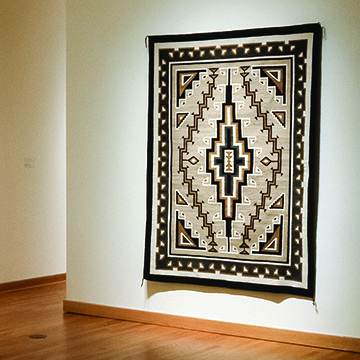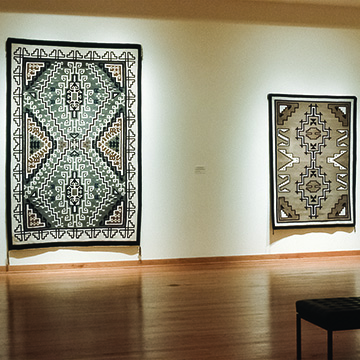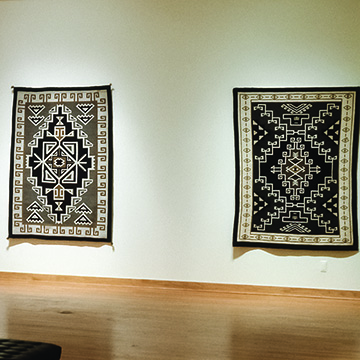Toadlena · Two Grey Hills
Toadlena/Two Grey Hills weavings are widely considered to be the pinnacle of 20th century Navajo weaving. The exhibition features 18 master works of the acclaimed regional style produced from about 1920 to present day. Two of the weavers included in the exhibition, Daisy Taugelchee and Bessie Manygoats, are regarded to be the finest and most innovative weavers of this century. This is the third show in four years with a focus on Navajo textiles: earlier exhibitions featured Classic period weavings and sandpainting designs.
Navajo weaving was profoundly affected by the economic hardships which weavers faced in the late 1800s. Following their forced internment at Bosque Redondo (1863-1868), the Navajo slowly rebuilt their flocks of sheep and eventually had surplus wool for trade. In 1880-81 the Atchison, Topeka and Santa Fe Railway completed its southern line, bringing in more trade goods to the American Southwest, as well as more visitors. Concurrently, trading posts began to flourish. The new customers at the trading posts, primarily Anglos, wanted textiles to use as floor coverings rather than as blankets for wearing. The advent of the trading post and the influence of traders on textile format and design eventually led to the development of regional styles of weaving. Additionally, in the early 20th century, numerous traders encouraged Navajo weavers to experiment with new motifs, including Occidental and Oriental, and mail order catalogs were published to promote rugs nationwide.
The serious economic need of the weavers contributed to their willingness to respond to traders’ suggestions regarding design innovations, along with their own aesthetic curiosity and inquiry. At Toadlena and Two Grey Hills, both in northwestern New Mexico, traders encouraged weavers to include a one- to two-inch wide dark brown or black border around their rugs to frame the design. This element immediately distinguished the rugs of this region from all others. Trader George Bloomfield, at Toadlena, and Ed Davies, at Two Grey Hills, began successful interactions with local weavers. Both Bloomfield and Davies promoted the exclusive use of natural wool colors of black, tan, white and gray – aniline dyes and Germantown yarns were ruled out.
By the 1930s, weavers in the Two Grey Hills and Toadlena region were recognized for their technical excellence in both preparation of materials and execution of complex design. Design innovations steadily appeared, and the concept of “negative space” was also employed. It was common practice for local traders to photograph outstanding work and distribute copies to other weavers to further innovation. As a consequence, widespread change in the overall style of the local rugs occurred.
In this exhibition, a diamond or double-diamond shape appears in the center of each work, and several include a rectangle radiating zigzags lines representing lightning in the Navajo “storm pattern.” The “water bug” motif featuring a winged-insect abstraction is another common design.
During the 1940s and 1950s, Toadlena/Two Grey Hills textiles gained renown for superlative technique and bold, complex compositions. These weavings became the most highly prized 20th century Navajo textiles, to a great extent because of the works of two extraordinary weavers: Bessie Manygoats and Daisy Taugelchee, each of whom has three rugs in the exhibition. Bessie Manygoats, born at the turn of the century and an innovative designer, shunned strict repetition of pattern: she might use an element from the border of one weaving as a focal point in another. Daisy Taugelchee, born in 1909 or 1911, further defined the Toadlena/Two Grey Hills style with her finely spun yarns and sensitively conceived designs. In the 1950s she was reported to be the world’s highest paid weaver. The well-known trader Gilbert Maxwell once remarked, “Daisy Tagelshee [sic]...is without a doubt in my estimation the greatest living Navajo weaver.”
The multicultural climate of the 1980s focused greater attention on Navajo weaving as a symbol of cultural identity at the same time that native artists were taking their places among mainstream artists. Increasingly, weavers’ individual styles and contributions were recognized. One of the works in the exhibition was woven by a man, a relatively rare example.
The most recent work in this exhibition, a 1997 weaving by Barbara Tsosie (b. 1927), reflects a sophisticated understanding of figure/ground and includes a “spirit line” with a single strand of yarn connecting the interior and the edge through the dark border; the intention was to release spirits that might otherwise be trapped within the work.
Today, as throughout history, Navajo textile designers grow out of complex interactions between individual artists and their families, communities and marketplaces. While the impact of traders on the development of regional styles cannot be denied, in the end, the weavers themselves are the indisputable creators of these extraordinary textiles.
We wish to thank the Two Grey Hills Weaving Museum, located at the Toadlena Trading Post, for its efforts on behalf of this exhibition. In 1997, the historic trading post was restored to its early 20th century style, and a museum focusing on local culture and the development of Toadlena/Two Grey Hills weaving was established. The museum's ongoing research and collections were critical to this exhibit.
The gallery guide essay was written by Jama Akers, Mission, Kansas, and Mark Winter, Santa Fe, New Mexico.





